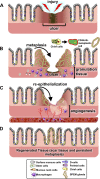Role of metaplasia during gastric regeneration
- PMID: 32755448
- PMCID: PMC7792674
- DOI: 10.1152/ajpcell.00415.2019
Role of metaplasia during gastric regeneration
Abstract
Spasmolytic polypeptide/trefoil factor 2 (TFF2)-expressing metaplasia (SPEM) is a mucous-secreting reparative lineage that emerges at the ulcer margin in response to gastric injury. Under conditions of chronic inflammation with parietal cell loss, SPEM has been found to emerge and evolve into neoplasia. Cluster-of-differentiation gene 44 (CD44) is known to coordinate normal and metaplastic epithelial cell proliferation. In particular, CD44 variant isoform 9 (CD44v9) associates with the cystine-glutamate transporter xCT, stabilizes the protein, and provides defense against reactive oxygen species (ROS). xCT stabilization by CD44v9 leads to defense against ROS by cystine uptake, glutathione (GSH) synthesis, and maintenance of the redox balance within the intracellular environment. Furthermore, p38 signaling is a known downstream ROS target, leading to diminished cell proliferation and migration, two vital processes of gastric epithelial repair. CD44v9 emerges during repair of the gastric epithelium after injury, where it is coexpressed with other markers of SPEM. The regulatory mechanisms for the emergence of CD44v9 and the role of CD44v9 during the process of gastric epithelial regeneration are largely unknown. Inflammation and M2 macrophage infiltration have recently been demonstrated to play key roles in the induction of SPEM after injury. The following review proposes new insights into the functional role of metaplasia in the process of gastric regeneration in response to ulceration. Our insights are extrapolated from documented studies reporting oxyntic atrophy and SPEM development and our current unpublished findings using the acetic acid-induced gastric injury model.
Keywords: CD44 variant isoform 9; cystine-glutamate transporter; gastric ulcers; spasmolytic polypeptide-expressing metaplasia.
Conflict of interest statement
No conflicts of interest, financial or otherwise, are declared by the authors.
Figures


References
-
- Ahluwalia A, Jones MK, Szabo S, Tarnawski AS. Aberrant, ectopic expression of VEGF and VEGF receptors 1 and 2 in malignant colonic epithelial cells. Implications for these cells growth via an autocrine mechanism. Biochem Biophys Res Commun 437: 515–520, 2013. doi:10.1016/j.bbrc.2013.06.096. - DOI - PubMed
-
- Ahluwalia A, Jones MK, Szabo S, Tarnawski AS. Aging impairs transcriptional regulation of vascular endothelial growth factor in human microvascular endothelial cells: implications for angiogenesis and cell survival. J Physiol Pharmacol 65: 209–215, 2014. - PubMed
Publication types
MeSH terms
Substances
Grants and funding
LinkOut - more resources
Full Text Sources
Miscellaneous

